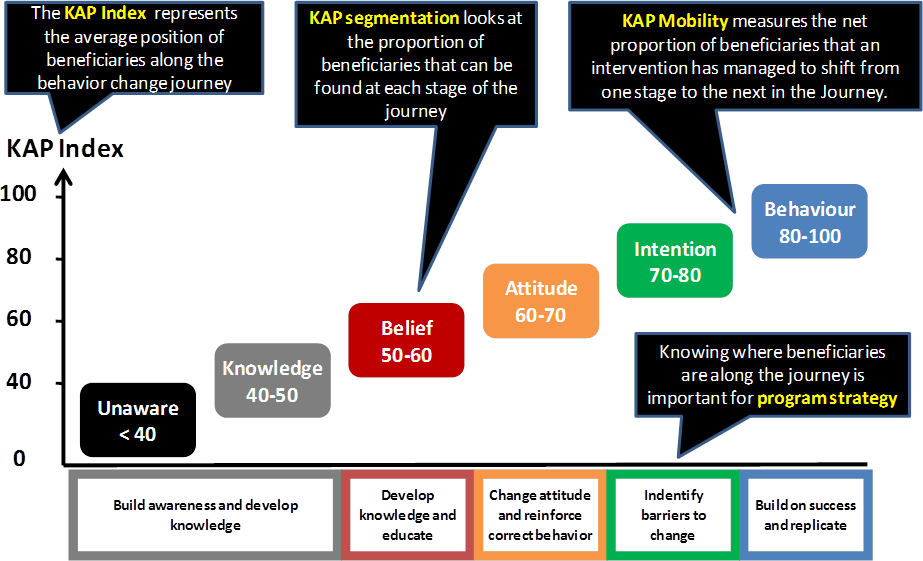KAP Score Model
Behavior change is not black and white but is better described as a journey. Popular behavior change theory (i.e. theory of planned behavior and the trans-theoretical model) describes how an individual moves towards behavior change through a series of stages. The process starts with awareness and knowledge building, moving on to belief formation and attitude change, and finally behavioral intentions and behavior change.
Based on this theory, Rapid Asia uses a proven model (i.e. KAP Score®) that is able to approximate the behavioral change journey and identify at which stage of the journey a beneficiary is at any point in time. A single intervention can seldom move a beneficiary through all the stages but can make a contribution by shifting them to a higher level in the journey, thereby reducing the overall risk level and increasing the likelihood of behavior change. For many programs, policy and law enforcement are important determinants to ensure behavioral intentions are reinforced resulting in real change.
It is important to note that the journey for an individual may not be linear, beneficiaries can skip stages both up and down and the distance between stages is not necessarily equal.

Behavior change communication alone can seldom move a person through all the stages but can potentially bring them to a point at which they have formed an intention to change provided there are no physical or environmental barriers to prevent them from doing so. Financial constraints, limited access, lack of law enforcement are examples of barriers that can prevent beneficiaries from taking the desired action. Hence, communication often needs to work hand-in-hand with other types of interventions to achieve the desired impact. Anticipating and including potential barriers in the overall measurement framework is a crucial element to consider.

Dividing the journey into stages also helps to better understand program strategy. If the target audience is trailing lower down the journey, interventions would focus on awareness and knowledge building. As mind-sets of the target audience develop, attitude becomes more important.
Based on past evaluations with over 180 independent samples, taken across more than 20 countries, a number of key indicators have been developed. The indicators can be used to measure intervention impact as well as making comparisons between different target groups and geographical areas. The KAP Index is a one number indicator that is ideal for comparing impact results across different target groups. KAP Segmentation looks at how people are distributed across the journey. The shape of the distribution and its position along the journey provide an insightful overview of the target population. Finally, KAP Mobility is an indicator that measures the extent to which target members have shifted up the journey as a result of an intervention. The larger the shift the larger the impact.


KAP Score by Rapid Asia Co., Ltd. is licensed under a
Creative Commons Attribution-NonCommercial-NoDerivatives 4.0 International License.

